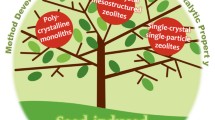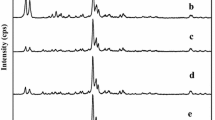Abstract
By means of milling and heating, the zeolite crystals can be radicalized forming surface non-bridging oxygen hole center (NBOHC, ≡Si–O·). The corresponding g values of 2.0043 and 2.0048 unambiguously confirm the existence of the ≡Si–O· radicals in the milled and heated crystals via electron paramagnetic resonance. The active ≡Si–O· radicals can react with water to form hydroxyl free radicals to accelerate the crystallization of zeolite along with seeds. Radicalized crystals are used as seeds that show obvious accelerating effect in the crystallization of Na-A and nanosized silicalite-1 than the non-radicalized seeds. At the same crystallization time, solid products with much better crystallinity and more yields could be obtained using radicalized seeds compared with non-radicalized seeds. A new seeding-synthesis-related strategy is developed to accelerate the crystallization of zeolites.





Similar content being viewed by others
References
Cejka J, Corma A, Zones S (2010) Zeolites and catalysis: synthesis, reactions and applications. Wiley-VCH, Weinheim
Kulprathipanja S (2010) Zeolites in industrial separation and catalysis. Wiley-VCH, Weinheim
Breck DW (1974) Zeolite molecular sieves. Wiley, New York
Xu RR, Pang WQ, Yu JH, Huo QS, Chen JS (2009) Chemistry of zeolites and related porous materials: synthesis and structure. Wiley, Hoboken
Li Y, Yu JH (2014) New stories of zeolite structures: their descriptions, determinations, predictions, and evaluations. Chem Rev 114:7268–7316
Cundy CS, Cox PA (2005) The hydrothermal synthesis of zeolites: precursors, intermediates and reaction mechanism. Microporous Mesoporous Mater 82:1–78
Chu P, Dwyer FG, Vartuli JC (1988) Crystallization method employing microwave radiation. US Patent 4 778 666
Iyoki K, Itabashi K, Okubo T (2014) Progress in seed-assisted synthesis of zeolites without using organic structure-directing agents. Microporous Mesoporous Mater 189:22–30
Kerr GT (1966) Chemistry of crystalline aluminosilicates. I. Factors affecting the formation of zeolite A. J Phys Chem 70:1047–1050
Feng GD, Cheng P, Yan WF, Boronat M, Li X, Su JH, Wang JY, Li Y, Corma A, Xu RR, Yu JH (2016) Accelerated crystallization of zeolites via hydroxyl free radicals. Science 351:1188–1191
Cheng P, Feng GD, Sun C, Xu WJ, Su JH, Yan WF, Yu JH (2018) An efficient synthetic route to accelerate the zeolite synthesis via radicals. Inorg Chem Front 5:2106–2110
Feng GD, Wang JY, Boronat M, Li Y, Su JH, Huang J, Ma Y, Yu JH (2018) Radical-facilitated green synthesis of highly ordered mesoporous silica materials. J Am Chem Soc 140:4770–4773
Narayanasamy J, Kubicki JD (2005) Mechanism of hydroxyl radical generation from a silica surface: molecular orbital calculations. J Phys Chem B 109:21796–21807
Schmidt P, Badou A, Frohlich F (2011) Detailed FT near-infrared study of the behaviour of water and hydroxyl in sedimentary length-fast chalcedony, SiO2, upon heat treatment. Spectrochim Acta A Mol Biomol Spectrosc 81:552–559
Schrader R, Wissing R, Kubsch H (1969) Zur Oberflächenchemie von mechanisch aktiviertem Quarz. Z Anorg Allg Chem 365:191–198
Hochstrasser G, Antonini J (1972) Surface states of pristine silica surfaces: I. ESR studies of Es′ dangling bonds and of CO2 − adsorbed radicals. Surf Sci 32:644–664
Watanabe T, Isobe T, Senna M (1996) Mechanisms of incipient chemical reaction between Ca(OH)2 and SiO2 under moderate mechanical stressing: II. Examination of a radical mechanism by an EPR study. J Solid State Chem 122:291–296
Watanabe T, Hasegawa S, Wakiyama N, Usui F, Kusai A, Isobe T, Senna M (2002) Solid state radical recombination and charge transfer across the boundary between indomethacin and silica under mechanical stress. J Solid State Chem 164:27–33
Inaki Y, Yoshida H, Yoshida T, Hattori T (2002) Active sites on mesoporous and amorphous silica materials and their photocatalytic activity: an investigation by FTIR, ESR, VUV–UV and photoluminescence spectroscopies. J Phys Chem B 106:9098–9106
Zeleňák V, Zeleňáková A, Kováč J (2010) Insight into surface heterogenity of SBA-15 silica: oxygen related defects and magnetic properties. Colloids Surf Physicochem Eng Asp 357:97–104
Li Q, Creaser D, Sterte J (1999) The nucleation period for TPA-silicalite-1 crystallization determined by a two-stage varying-temperature synthesis. Microporous Mesoporous Mater 31:141–150
Nawrocki J (1997) The silanol group and its role in liquid chromatography. J Chromatogr A 779:29–71
Tavazzi S, Ferraro L, Cozza F, Pastori V, Lecchi M, Farris S, Borghesi A (2014) Hydrogen peroxide mechanosynthesis in siloxane-hydrogel contact lenses. ACS Appl Mater Interfaces 6:19606–19612
Acknowledgements
We appreciate Prof. Jihong Yu and Wenfu Yan in Jilin University for helpful discussions. This work was supported by the National Natural Science Foundation of China (Grant No. 21701117), the Natural Science Foundation of Liaoning Province (20180550062), and the Special Fund of Liaoning Provincial Universities’ Fundamental Scientific Research Projects (LZD201702, LQN201706).
Author information
Authors and Affiliations
Corresponding authors
Ethics declarations
Conflict of interest
The authors declare that they have no conflict of interest.
Electronic supplementary material
Below is the link to the electronic supplementary material.
Rights and permissions
About this article
Cite this article
Cheng, P., Song, M., Zhang, H. et al. Accelerated synthesis of zeolites via radicalized seeds. J Mater Sci 54, 4573–4578 (2019). https://doi.org/10.1007/s10853-018-3178-3
Received:
Accepted:
Published:
Issue Date:
DOI: https://doi.org/10.1007/s10853-018-3178-3




